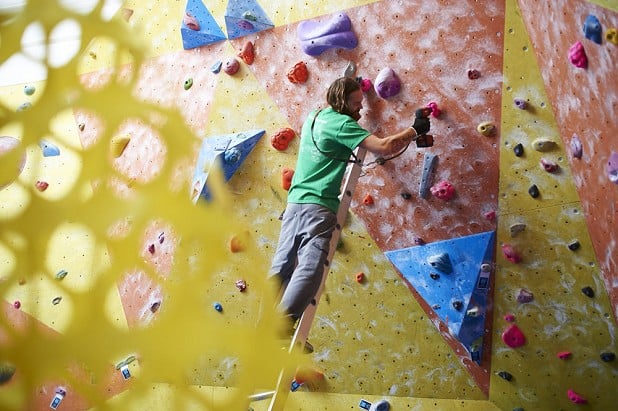
Every indoor climber has experienced route setting and knows there is something more behind it than just throwing some holds on a wall, but how do they do it and what are the setters thinking? Nate McMullan is a Professional route setter, route setter trainer, founding member of the RSA (Route Setting Association) and Managing Director of Climbing Wall Services. In this article he gives an insight into the work of route setters along with some helpful tips, whether you're just starting out at your local wall or have been setting for a while.
Route and boulder setting is a really difficult job to do at a high standard, and I don’t mean at hard grades, I mean to make great sequences for the climbers at all levels. When I set, it is the creative side which takes the effort, obviously we have to be safe while working but once you do it for a while the access is second nature.
So, what am I thinking when I create a problem or route? Well the first thing a setter needs is a clear brief from the client; who are the problems for? What difficulty? Is it a lead route? All these things start the process but the next step is also critical; what holds are there? The biggest issue I have is making do with poor holds or not enough holds to set what the client wants – it is like asking for a for a painting and giving the artist a stick to paint with – not impossible but not easy! Facilities which want good setting should invest in good holds.
Once I know the setting brief, what holds I have and the area of wall to be set, I think about the movement and the general effort it takes to do the climb at the grade to be set – this is not just about the difficulty in finger strength but also unlocking sequences, body position and footwork. Normally I try to remember the feel of a climb I really liked at a similar grade – not trying to copy the route or problem (as this is almost impossible) but getting the same tone. I think only very experienced climbers can set like this due to huge library of moves that needs to be in your mind – but new setters can get a few shortcuts:
- Climb loads at the grades you want to set at. If your brief is to set 5+ and you have not climbed one in years it is going to be hard to set!
- Sample other walls' setting, and have an open mind – different setting is like a new rock type, it may be an acquired taste and don’t disregard it immediately
- Check the ego. The climbers are paying your wage and professional setting means making them enjoy the climbing and want to come back – it can be hard but it needs to be fun and safe
- Watch climbers on your sets and be open to feedback – this is one of the hardest things as not all feedback is useful and some is nonsense – I find it best to actually watch, you can tell if they liked what they are climbing
- Whilst setting a problem to suit all shapes and sizes is virtually impossible, be wary of going to extremes and setting repeatedly overly-reachy or bunched-up moves. You can't please everyone all of the time, but try and have some variation at least
Getting faster at setting is the next key to actually making some money, so how can do you do it? Practice is the most important thing, and not just putting up a few routes with no time constraints (if you set 3 routes a day they better be really steep and long!) I mean give yourself a time limit – like 2 routes in 40 min at 10meters, vertical in the mid grades. This is a good starting point but once you work under pressure it becomes obvious that the actual setting is the easy bit – it is the faff which kills speed. To be fast you have to work smart and work hard, being efficient is key to avoiding any unnecessary effort. This is not obvious but if you watch or work with other setters you pick up points so here are a few:
Preparation:
- Batteries, the right bits, enough holds, bolts and screws are obvious but prep and separate holds and bolts – use hoist systems and wide bags with internal dividers
Efficiency:
- Routes: Can you set 1 up and 1 down? 2 up and 1 down? Or 3 at a time? This all takes practice and a focussed mind not to get lost
- Bouldering: Are you using a tool belt which separates bolt lengths, bits and can carry a few holds? The less you have to go up and down a ladder the safer / faster / easier it is. Consider using an impact driver on a sling to free up hands and work faster
- General: do you have to try each move? Experienced setters can visualise the move and rarely have to test the sequence while setting (I try test at the end in a group if possible to get feedback)
- Speed: Just let it flow – don’t try to be clever because it normally won’t work. Overthinking slows things down, yes that forced bat hang might be cool but if it takes you 3 hours to set it your boss is not going to be happy!
- Work in a good team with lots of coffee (well it helps me)
- Have time challenges – in the next hour I will set x problems / routes
Grading is the most highly debated area of route setting and there is no easy answer, being able to grade is hard at any time but after setting hard for a day (or two or three) it is nearly impossible, but there are a few tricks:
- Use “forerunners” (a US term for testers): Basically get some help during the testing and grading stage with some keen climbers – however be aware of their strengths, if the graders normally flash 7c there is very little chance they can tell a 6a and 6a+ apart.
- Grade in teams: If forerunners are not an option grade in teams and get a consensus.
- Use a tare point: get a standard climb / problem of a grade and work away from it
- Be aware of your own strengths and weaknesses – try to grade for the “average” climber for the grade
- Allow for customer feedback / adjustment of grades – remember they are the ones who matter
- Remember to adjust the given grade if the holds are damp from washing or will become packed with chalk, therefore harder to hold as the set ages
Some facilities use circuits and bands for grading, which makes it easier for the setter, but maybe not as good for the customers – personal choice really and you need to be able to set as the wall dictates. Regardless, being able to set to a given grade is critical in professional setting, which is slightly different than actual grading en-masse but try not to stress as it won’t ever be correct for everyone.
Final thoughts; have fun, set for your climbers to have fun and practice makes perfect!















Comments